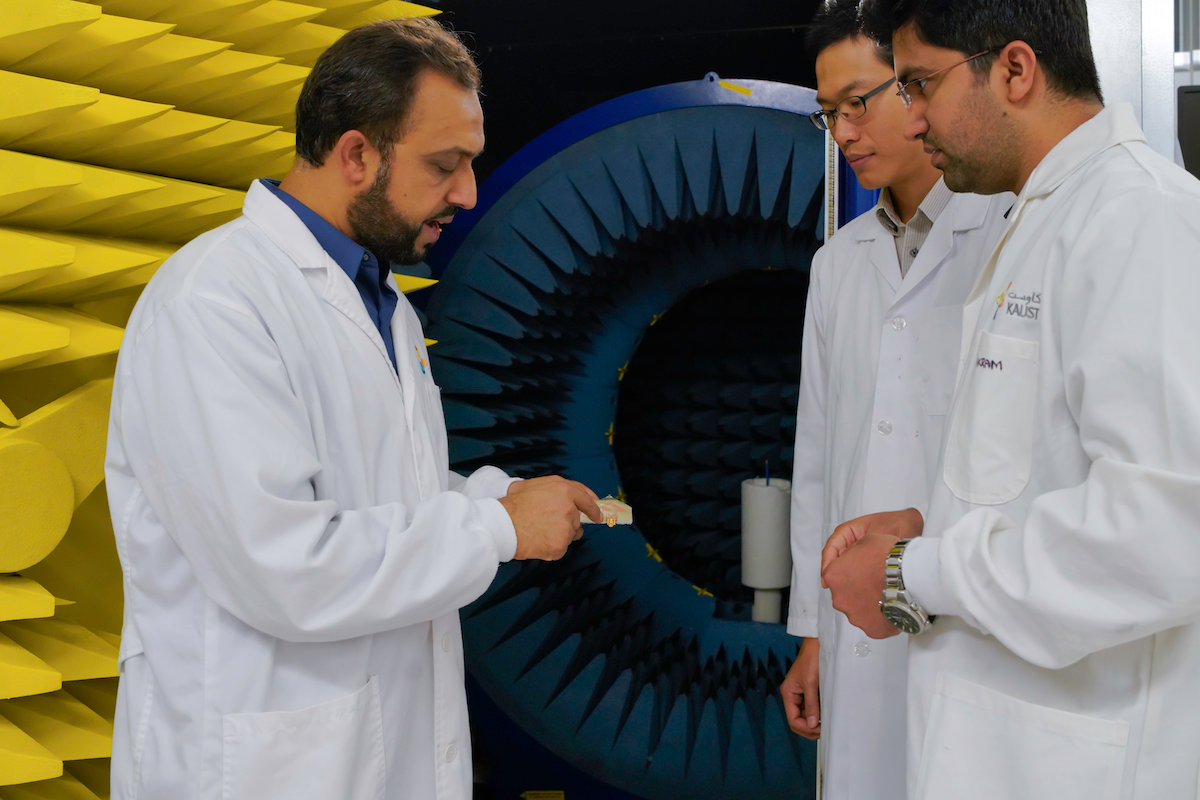The internet of sea things

Associate Professor of Electrical Engineering Atif Shamim (left) discusses the project with KAUST postdoctoral fellow Yen-Hung Kuo (middle) and Ph.D. student Muhammad Akram Karimi (right). Photo by Andrea Bachofen-Echt.
-By Sonia Turosienski, KAUST News
When Atif Shamim, KAUST associate professor of electrical engineering, was approached by colleagues in the University's Red Sea Research Center (RSRC) with the challenge of developing underwater sensing technology for marine animals, he wasn't sure how his expertise could help, since marine animals are under water most of the time. Up until now, his research has focused on Bluetooth for applications on dry land, such as wearable medical devices connected to smartphone applications through Bluetooth communication protocol.
Marine researchers, however, had no alternative to heavy and sometimes invasive tags when tracking animals in the sea. Sensor data is collected in an offline manner after taking the sensor tag is retrieved. The process of retrieving tagged animals is not only invasive, but also impractical in most cases.
After overcoming numerous challenges related to the unusual specifications of the marine tag, Shamim, along with postdoctoral researcher Yen-Hung Kuo and Ph.D. student Muhammad Akram Karimi, developed a hybrid, wireless communication system for non-invasive monitoring of physical parameters of the sea and activity level of various sea animals.
The system consists of a lightweight, flexible, Bluetooth-enabled tag that stores the sensor data when the sea animal is deep under water. As soon as the sea animal rises to the surface, the tag automatically syncs the stored data to floating receivers on the surface.
Mobile in near real time
When tagged marine animals surface, data is wirelessly transmitted to floating receivers, which have built in Bluetooth and GSM capabilities. Sensor data is then relayed to the GSM network to be viewed from anywhere in the world. Where there is no GSM connection, drones scan the area and pick up the signal from floating beacons. These safe, easy-to-apply tags and floating receivers provide researchers with detailed, near real-time data about the animals they are studying.
The project is part of an inter-disciplinary collaboration between the Red Sea Research Center and three research groups, including Shamim's, within the electrical engineering department, who form part of the KAUST Sensor Initiative. Jürgen Kosel, associate professor of electrical engineering, is developing magnetic sensors for future integration, while Muhammad Mustafa Hussain, professor of electrical engineering, is working on adding flexible temperature, salinity and pressure sensors.
Two prototypes of the flexible, lightweight, Bluetooth-enabled marine tag are shown in this image. Photo by Andrea Bachofen-Echt.
"This is a challenging project. We've done some flexible work in the past, but we faced some new challenges," Shamim explained.
One of the biggest challenges in designing such a wireless tag was to ensure good wireless communication irrespective of the tag's orientation, as the animal position, on which the tag is mounted, is unpredictable.
"You want to get radiation all around and you need a vertical element for that. We couldn't have a vertical element so the design had to be completely flat, yet perform like a three-dimensional model," Shamim added.
The team was able to create a special flexible antenna that achieved near isotropic radiation pattern while maintaining a flat profile. The tag also needed to retain performance while maintaining flexibility and exposure to harsh sea conditions. The final challenge was attaching the integrated circuit, which is typically soldered on, to the flexible tag. The lightweight materials mean that heat is not an option, which led the team to explore specialized epoxies.
Innovation in design and function
The tag itself was not the only opportunity for the team to innovate. On a system level, the Bluetooth tag works with a Bluetooth and GSM-connected floating receiver (beacon). Shamim, Kuo and Karimi have big plans for the next evolution.
"The plan for this year is to integrate ultrasonic. When we do this, it will be the first ultrasonic, GSM and Bluetooth connectivity in tagged animals," Shamim explained.
With ultrasonic connectivity, the researchers will have real-time data and will not need to wait for the animal to surface to read the data.
The tag has been successfully tested on several marine animals in Valencia, Spain. The project has attracted attention from Spanish media as well as a short interview with the students who participated, which will be featured on the National Geographic Channel. The tag was also presented to Saudi Crown Prince Mohammed bin Salman as part of the 2018 Innovation to Impact Forum, which took place in Massachusetts in March.
Later this year, Shamim hopes to demonstrate a full demo on campus with tagged animals, receivers and live data on screen.
"When the RSRC wanted to do something like this with sensors, it just so happened that our capabilities matched with their needs. It's exciting especially because we know nothing like this exists in the market, so it will be a real contribution," Shamim concluded.
Related stories:
- Developing disposable lifesaving sensors
- Hussain is taking a flexible approach
-
Smart skin for flexible monitoring

